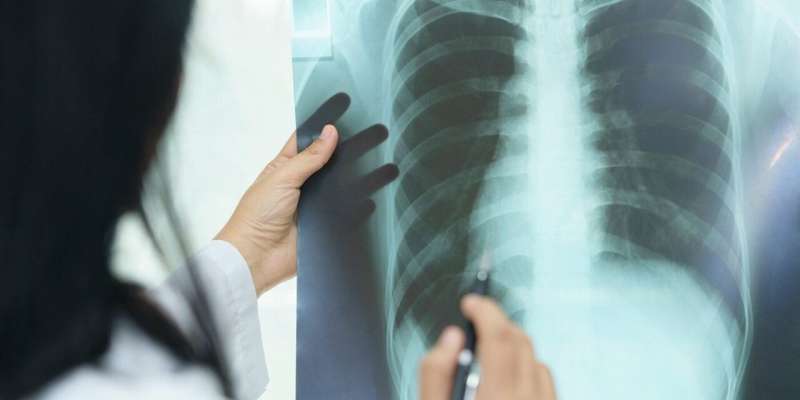This article has been reviewed according to Science X's editorial process and policies. Editors have highlighted the following attributes while ensuring the content's credibility:
fact-checked
peer-reviewed publication
trusted source
proofread
Study: India has a long way to reach zero catastrophic costs goal for TB patients

A recent study led by Dr. Susmita Chatterjee from The George Institute of Global Health, India, has shed light on the long-term economic impact of TB on patients, even a year after the end of treatment. The study has also shown that India still has a long way to go to reach the goal of zero catastrophic costs for all patient groups, as stated in the END TB Strategy. As an outcome of the understanding, the scientists have recommended a few strategic solutions to reduce the catastrophic impacts of TB in India.
Reducing delays in diagnosis and treatment initiation (patients visit on average 12 health care providers before getting diagnosed with TB) can reduce the costs associated with TB treatment, its aftermath, and its related economic consequences. Creating awareness about the symptoms of TB in the community and availability of free diagnostic and treatment facilities in the government sector is crucial in this regard, they say. They also recommend that policy changes must ensure that the livelihood of TB patients is not disrupted and hence, the changes should include the provision of job security, additional food support, better management of direct benefit transfers, and improved medical insurance coverage.
Other than The George Institute for Global Health, India, researchers from Indira Gandhi Government Medical College in India, the University of New South Wales (Australia), and the London School of Hygiene and Tropical Medicine (U.K.) also participated in this study. The study that underscores the importance of understanding the economic impact of TB on patients and their households has been published in PLOS Global Public Health, in a paper co-authored by Dr. Susmita Chatterjee, Senior Health Economist—The George Institute, India, Palash Das, Research Fellow—The George Institute India, Aaron Shikhule—University of New South Wales Australia, Radha Munje—Indira Gandhi Government Medical College, and Anna Vassal—London School of Hygiene and Tropical Medicine (U.K.).
Highlighting the importance of the study, Dr. Susmita Chatterjee, Senior Health Economist, The George Institute, India, said, "India bears the highest burden of TB in the world, with 26.4 lakh cases reported in 2019 alone. Not only does the disease impact the health of individuals, but it also has significant economic consequences and we quantified those consequences to take protective action."
The study, conducted between 2019 and 2021, examined the experiences of 829 adult patients who had TB that is responsive to medication (drug-susceptible TB). Study participants were from general population and from two groups who are at high risk of having TB because of their poor living conditions and nutrition: people living in urban slum areas and tea garden areas.
Each participant was interviewed three times: once at the beginning of treatment (0–2 months) then during the continuation phase of treatment (5-6 months) when they were almost finishing their treatment, and finally post-treatment i.e., 8–12 months after treatment was completed.
Elaborating on the details of the survey, Dr. Susmita Chatterjee said, "The collected data covered socio-economic conditions, employment status, patient and household income, out-of-pocket expenses, and time spent on outpatient visits, hospitalization related to TB, TB drug pick-up, medical follow-ups after initiation of TB treatment, expenses on additional food during TB treatment, and coping strategies such as dissaving, borrowing, and selling assets."
The observations were disturbing as the total cost of TB treatment from the onset of symptoms to one-year post-treatment ranged from Rs. 26,500–30,500 per patient despite free diagnosis and treatment provided by the government. Of this, 32% to 44% of costs were incurred in the pre-treatment phase (i.e., from the initiation of TB symptom till initiation of treatment), while 6%–7% were incurred in the post-treatment phase. The unemployment rate was seen to increase from pre-treatment (before TB) to the intensive phase (i.e., at the beginning of TB treatment), but decreased during the continuation phase (i.e., at the end of TB treatment), although it remained above the baseline even after about one year of treatment completion.
The low income of the patients along with high unemployment because of TB forced them to borrow money and/or sell / mortgage their personal belongings during treatment which resulted in a high outstanding loan in the post-treatment phase. Further, to manage the outstanding loan, they had to borrow/sell/mortgage during the post-treatment period as well.
Apart from that, there were other economic consequences that included reduced food consumption for family members as they ensured proper food for patients; inability to pay regular bills such as electricity, mobile, cable etc.; buying regular groceries on credit; not being able to attend events like weddings or other social functions as they did not have money to buy gifts or for travel both during treatment and post-treatment period. This clearly emphasized that the economic impact of TB does not end with the completion of the TB treatment: it continues long after.
"Interestingly, our study indicated that financial insecurity affects patients across all categories," said Dr. Susmita Chatterjee.
More information: Susmita Chatterjee et al, Journey of the tuberculosis patients in India from onset of symptom till one-year post-treatment, PLOS Global Public Health (2023). DOI: 10.1371/journal.pgph.0001564





















